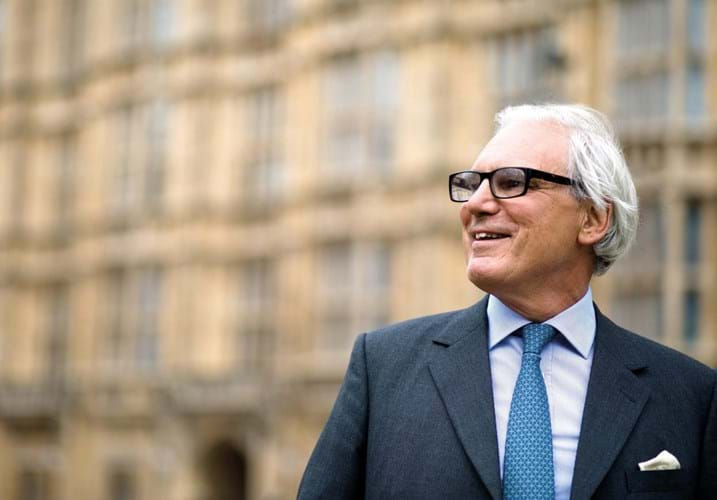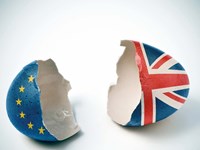
The phrase “it is not what you know but who you know” rings true for lobbyists, those who operate in the shadows, trying to persuade government behind the scenes to shape legislation to suit their chosen course.
As one anonymous lobby man was once quoted: “The influence of lobbyists increases when it goes largely unnoticed by the public.”
But this is only half true for Anthony Browne of the British Art Market Federation, an Old Etonian who moves between the worlds of quiet diplomacy and more overt lobbying on the art market’s behalf. Browne is adopting the latter approach this week with the public launch of The British Art Market Report 2017, updated from 2014’s edition.
For his job is about what he knows – he’s a Christie’s lifer – and who he can get to know to ensure the art market’s interests are represented with policy makers.
Over the past 20 years he has been chairman of the umbrella body, getting to know key figures in government and parliament – from civil servants and special advisers to ministers and those sitting in the House of Lords.
Lifelong career
However, when he meets with ATG, Browne is at pains to stress he is not a professional lobbyist or a “hired gun”.
He represents the sector because he has spent his entire working life in the art market. He joined auction house Christie’s as a trainee straight after university in the early 1970s and remains a senior consultant with the firm (see CV, below).
Politics was always on the cards: his father was Percy Browne, a Tory MP for Torrington in Devon.
The lead-up to his current role at BAMF took shape over a number of years while he worked his way up at Christie’s. “I gradually morphed into what I do now,” he says.
When Lord Carrington (Margaret Thatcher’s former foreign secretary) became Christie’s chairman in 1988, Browne worked closely with him and learnt the politician’s craft. “He was an extremely impressive statesman,” says Browne.
In the 1990s the Fine Art Trade Working Party was formed, a forerunner to BAMF – a more formal entity created at the suggestion of the Tory government.
Browne spends his time between Christie’s and meetings in Whitehall. He is certainly ‘clubbable’ – with an entry in Who’s Who, he fits right in to the old-school world of UK politics.
Browne has the contacts and will need them as he faces one of his toughest challenges yet: Brexit. But armed with BAMF’s latest report, he believes he has the weapon to make the art market’s case to government.
Curriculum Vitae
1996
BAMF founded with Browne as chair
1996–present
Christie’s International, senior consultant
1978–1996
Director at Christie’s
1971
Joined Christie’s as a trainee after university
Education
Eton College, Christ Church, Oxford (MA Modern History)
Q&A
ATG: This report updates The UK Art Market in 2014 and follows reports published in 1997 and 2010. Why did BAMF decide to publish a new one this year?
Browne: The reason was Brexit. We are embarking now on a particularly challenging period and we wanted to make sure that government was aware of our significance in terms of jobs, economic generation, tax and the fact that we are a globally successful sector.
But there’s no point going to government and saying ‘listen to us, we’re nice guys’. We are the second-largest art market in the world and a British success story, but we have to have the data to show why the government should bother with us.
How do you deal with differing art market views on Brexit?
Whatever people’s views are, I have to deal with the world as it is – not how people wish it to be. Brexit, as far as we can understand, is going to happen. So we need to make sure we get our priorities heard. Our challenge is to take advantage of the desire to ‘take back control’ and get the government to look at the issues that are important to us and make changes that would improve our global position. This is an opportunity to improve the UK’s global competitiveness.
Can you summarise the findings of the report?
This report lays out the opportunities for the future. The UK has maintained a dominant position in the international art market, but there is no room for complacency.
Global competition is increasing, particularly with the rapid growth of China (the BAMF report calculates that China has 20% global share with 21% for the UK). Although the UK has managed to hold its own in the global rankings, in the 10 years to 2016 UK art sales have fallen by 18%, in a period when global sales advanced in value by 4%.
How will BAMF use this report to make the case to government?
The launch of this report will be two-pronged. Robert Jenrick MP has kindly arranged for us to launch it at Portcullis House on July 18. We have invited MPs and the report’s author, Dr Clare McAndrew, will present and answer questions. I will say a few words about the opportunities that lie before us.
We follow this at RICS’ headquarters in Parliament Square with a wider event and presentation later that day. The report is accompanied by a summary leaflet highlighting our key objectives which is intended for MPs with little time.
How does your lobbying work?
I meet members of government, MPs, civil servants, special advisers. My job is to get to know these people, to put across the needs of the art market. An important thing is to brief people at a very early stage. In some cases you get a straw in the wind – that is when you can influence policy. Once a green paper has been issued, then the positions are more solidified and it is often too late to make changes. So much of what I do is about quiet, early discussions.
“We want assurances that we will have practical arrangements to trade with the EU
The majority of your work takes place behind closed doors but some readers tell us they want to know more about what you are doing.
Any of ATG’s readers who belong to one of our member organisations, such as the British Antiques Dealers’ Association or LAPADA, will be kept informed on what BAMF is doing. I am completely dependent on the member organisations to inform their members. I don’t have the time or the resources to update everyone, but these organisations are very good at keeping people informed.
We’re doing an awful lot. If you are not a member then you will inevitably not be as well informed. But, of course, even non-members of the trade benefit from our successes too.
Does quiet diplomacy work in all cases? Is there an argument for being more public in your efforts?
It is not either/or. It is about where you will get the most traction. Public campaigns can sometimes be right. But so much of what I do is not something I want to shout about.
Often it concerns complex issues that cannot be reduced to a simple message or soundbite. For instance, the ivory debate. It is highly charged and with shocking photographs of dead elephants it is hard to get across the case for older ivory objects.
This is a subtle argument and public debates tend to be simplified soundbites and social media. I believe the most important thing is to get our arguments across to informed people – the NGOs and agencies, the government, the civil servants.
In a public campaign our message could be lost. The fact that you don’t hear about what is going on doesn’t mean things are not happening. Very often, if it comes out into the public domain too early, it can become too controversial, whereas with dialogue progress can be made. It isn’t that I am shy of publicity – it is more about getting the timing right.
What are the top priorities for BAMF to discuss with government?
Our topics of discussion and top priorities are trade, taxation, Artist’s Resale Right (ARR), cultural legislation and employment and visas.
Trade with the EU will still be very important after Brexit. McAndrew believes around 20% of our trade is with Europe. We want assurances that if we leave the Single Market, we will have efficient and practical arrangements in place to trade with the EU – in the prime minister’s words, for “frictionless trade”.
The next key area is tax. The VAT margin scheme is absolutely vital, while import VAT is an impediment to cross-border trade. We believe the economic benefits of reducing or ending import VAT outweigh the small amount of revenue – around £49m a year – the government receives from it.
Another issue is visas and employment. We need the best talent if we are to maintain our position in the global marketplace. Of course, much of this cannot change until after 2019 [the two-year window for Brexit negotiations closes after spring 2019], but we need to be talking about it now.
What are the key government departments that you liaise with?
BAMF has been going for a long time now and we are looked upon by government as the place to go to understand the art market.
We deal with a lot of departments across government. We have a good dialogue with the Department for Digital, Culture, Media & Sport (DCMS), it is our sponsoring department and I talk to them on a very regular basis. In terms of Brexit, it is the department that will co-ordinate the interests of the art market across government and have put together a team to do this. We obviously work with the Department for Exiting the European Union, among others. There are issues that come under other departments such as tax with the Treasury, Defra on CITES, the Department of Business on ARR and also the Department of Trade. We deal with them all.
“It’s helpful to have a number of routes to government but the key thing is to deliver the same message
Which is more important: relationships with civil servants, MPs or ministers themselves?
It is very important to have good relations with many levels of government – it is my job to meet people and build those relationships.
Civil servants are important because they maintain the continuity between the change of governments, and they know the nuts and bolts of issues. But it is the ministers who make decisions. Special advisers are also very important as they have the time to get to know and understand issues to brief the ministers.
Is it more effective that the industry speaks with one voice, through BAMF, or do you think that as many voices as possible help?
BAMF was formed in 1996 on the suggestion of government, as it recognised the importance of the market and said it would be helpful if the market as a whole could speak with one voice. But it is helpful to have a number of routes to government.
The key thing is we have to be delivering the same message. It adds to BAMF’s strength to have big-hitters in organisations and at the key salerooms. But it has to be a coordinated effort.
Your role at BAMF is part-time. How does it operate with such a small team?
BAMF is an astonishingly lean machine. We run on a small budget and depend on contributions in kind from our members in terms of their time and their expertise. Our strength is in this expertise from our members.
I couldn’t do the job without them and their specialist expertise. We pool resources. The lawyers, specialists and experts at Christie’s, Sotheby’s, Bonhams, Phillips, SOFAA – I depend on these people.
I also pay tribute to BADA’s Mark Dodgson, for being a stalwart particularly on issues around CITES. Also BADA’s chief executive, Marco Forgione, who has really made the case against quarterly reporting, Rebecca Davies at LAPADA for playing a major role, and Christopher Battiscombe at Society of London Art Dealers, who has great experience.
Since Victoria Borwick lost her seat in the election, the antiques trade has one less voice in parliament. Does this concern you?
I very much regret Victoria’s defeat. In the short time she was in parliament, she contributed a huge amount for all of us. I am very grateful to her.
But there are many MPs I know who are supportive. I do have a lot of friends in parliament and in the House of Lords who help me, but of course my job is get to know more.
Do you find parliament a less friendly place now? Has your job got tougher in recent years?
No, it hasn’t got tougher. I find it endlessly fascinating. If I found it overwhelming, I wouldn’t do it. It is, of course a challenge, but also very rewarding. The art market is more interesting than many sectors that MPs deal with. I have never found that I can’t get people interested.
But you have to pick your moments. You can’t go banging on about your case all the time.
You also very rarely get a total victory. Politics is about compromise. My role is to get the best deal we can for the art market.
How much time do you spend working on BAMF issues?
I have a day job working at Christie’s. The time I spend on BAMF issues depends on what is going on.
But there are points when I can be very busy indeed, talking to departments and meeting MPs. I spend all the time necessary to do the job, is how I would put it.
BAMF’s priorities for the British art market
1. UK/EU trade
Essential to have: rapid and efficient customs clearance, electronic processing and export licences
2. Taxation
Focus on VAT: margin scheme should be maintained, scrap import VAT
3. Artist’s Resale Right (ARR)
Damages UK competitiveness. BAMF has commissioned a study on its impact
4. Cultural legislation
Reduce administrative burden if common system for licensing exports no longer applies after leaving Single Market
5. EU citizens/overseas visas
EU citizens here should have right to remain. Access to EU citizens is important: “It is vital to keep door open for the brightest and best talent from around the world,” Browne says
The British Art Market 2017: Key points
The British Art Market Report 2017 follows previous studies in 1997, 2010, 2014. This year it has been created to help BAMF ensure the government is aware of the significance of the British art market as Brexit negotiations gain momentum.
The British art and antiques market in numbers (figures are from 2016):
21%
Share of global art and antiques sales by value
2nd
Britain is the second largest market worldwide
£9.2bn
It has an overall value of £9.2bn ($12bn)
18%
Fall in sales in a decade (compared with 4% global sales rise)
£1.5bn
Paid in UK taxes in 2016 by the art market














